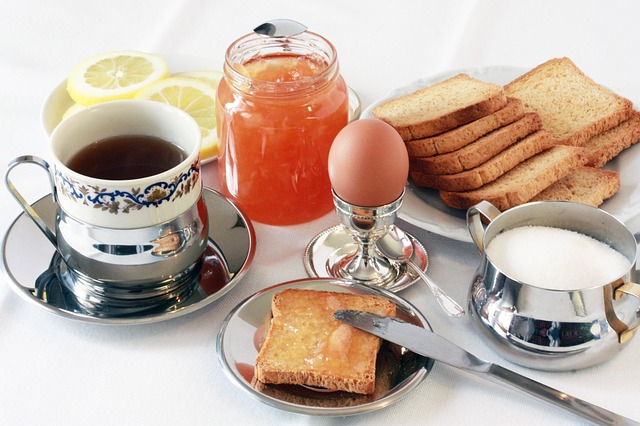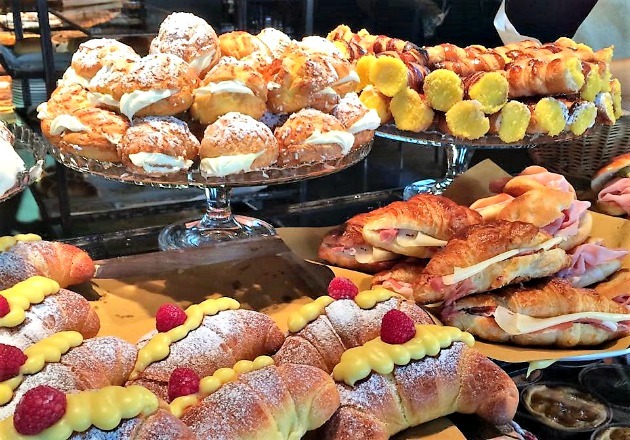What do Italians eat for breakfast? What is the typical Italian breakfast made of? Discover the delicious elements of the traditional Italian breakfast and get ready for a delicious morning meal, Italian style
Food is one of the many reasons to travel to Italy.
Pizza, risotto, more shapes of pasta than the average person can learn in a lifetime are only some of the things that make Italy such a paradise for foodies, Italian delicacies spanning from drinks, to mains to desserts.
Dinner is the meal that usually gets the most attention however, I believe the pleasures of Italian food can be enjoyed from the very start of the day, in the form of a traditional Italian breakfast.
But what do Italians eat for breakfast? What are traditional Italian breakfast foods and is Italian breakfast the same as continental breakfast?
A born and bred Italian, today I share all you need to know about the Italian breakfast.
Table of Contents
Italian breakfast foods chart
| Italian breakfast item name | Type | Common Italian breakfast food |
| Coffee (caffe’) | Drink | Homes/Cafes/Hotels |
| Milk and coffee drinks (cappuccino, latte macchiato etc) | Drink | Homes/Cafes/Hotels |
| Cocoa Milk | Kids drink | Homes/hotels |
| Tea (black, served with lemon or milk) | Drink | Homes/Cafes/Hotels |
| Orzo (barley brew) | Drink | Homes/Cafes/Hotels |
| Bread butter and jam | Sweet breakfast | Most traditional Italian breakfast foods at home and in hotels |
| Fette Biscottate | Typical Italian breakfast gallettes | Homes/Hotels |
| Cornetto | Italian croissant – Italian breakfast pastry | Cafes/hotels |
| Saccottino/Bauletto/etc: names vary by region and establishment | Italian breakfast pastries filled with chocolate, custard cream or jam | Cafes/hotels |
| Bread and nutella | Kids breakfast item | Hotels/ some households |
| Cereals | Breakfast cereals | Increasingly common in households/ common in hotels |
| Italian breakfast biscotti | Dunkable breakfast biscuits | Homes/hotels |
Italian breakfast at home and in smaller B&Bs and guesthouses
The real Italian breakfast, the one Italians actually put on their table in the morning and feed their kids before rushing them to school is a rather simple affair.
This is what you are likely to find if having breakfast in a smaller B&B and family rind guesthouse and what locals are likely to offer you if you happen to be in a private home.
Pane, burro e marmellata (bread, butter and jam)
The staple of this meal are usually coffee (more rarely tea) and bread, usually with a thin spread of butter and jam on top.
The type of bread used varies from region to region and each family has their favorite type however, bread in Italy tends to be fresh rather that packaged.
Bakeries and supermarkets with fresh bread counters are common and while you don’t rush out of the house before breakfast to get your daily dose of oven fresh bread, families usually keep the bread from the previous day (sometimes freezing and heating it back up) rather than buy industrial style ones.
Fette biscottate
People who are trying to keep their weight down or prefer a more crunchy start of the day often go for the quintessentially Italian ‘fetta biscottata’.
Literally a ‘tasted slice’, ‘fetta biscottata’ is a packaged type of gallette of mild taste, used as a support for butter and jam.
They are surprisingly tasty and in recent years they have exploded in popularity with a myriad of different types sold on the market: plain, whole grain, multi grain… you name it, you find it!
Biscuits for breakfast
Children but also adults often opt for a serving of biscuits with their morning milk.
This supersizes many who may be more used to thinking of biscuits as a complement to tea in the afternoon but having biscuits for breakfast is very common in Italy and a habit hard to break if you happen to pick it up while there.
There is not hard and fast rule about what type of biscuits to dunk in your meal but the country has some favorites, that have appeared on the tables across the nation for decades, such as gentilini.
If you want to have breakfast like an Italian, the best choice falls on biscuits that are reasonably plain and can take the soaking without crumbling miserably in your cup of coffee.
The best way to choose is a trip to the breakfast aisle of one of Italy’s supermarkets: the choice is vast and very, very different in style from what you find in the rest of Europe!
What about cereals?
Cereals are not part of the traditional Italian breakfast however, influences from the US and powerful marketing campaigns from cereal producers have put breakfast cereals firmly onto Italian tables.
They are a reasonably common breakfast staple for kids nowadays and if you are worried about availability, don’t be.
While the selection of cereals in Italy may be smaller than in the US or UK, you will find different types in the supermarket aisle ranging from very plain ones to chocolate and sugary ones.
Italian breakfast in hotels
If staying in hotels during your Italian vacation you are likely to find a different type of breakfast than the one described above.

Hotel chains and bigger establishments have learned a long time ago the taste of many of their visitors and nowadays cater for them with a vast selection of options that includes Italian staples but also borrows from central Europe and, sometimes, the UK and the US. This is what they usually call ‘continental breakfast’
Hotel breakfast usually include a selection of bread options and croissants, cakes (usually ciambellone and apple cake), plain biscuits, yogurt and cold cuts (ham, cheese).
Cooked breakfast is not as common in Italy although some hotels catering for large international numbers and higher end hotels are usually able to cook eggs in several styles.
Pancakes or the traditional English breakfast is hard to come by and not a common offering.
Italian breakfast on the go: colazione al bar
The best known of all types of Italian breakfast is probably the one you see in the morning in Italian bars (=cafes): people standing at the bar taking a shot of espresso and munching on an Italian croissant (cornetto) or bombolone or, in Rome, maritozzo.
Fun fact: a croissant is called ‘cornetto’ in Rome and ‘brioche’ in Milan – If you ask for cornetto in Milan, you get an ice-cream!
Conretto is the most common type of breakfast pastry in Italy and you can have it simple/ plain, with jam, chocolate or Italian custard (cornetto alla crema).
Good to know! ‘Crema’ in Italian is not whipped cream or cooking cream (they are called ‘panna’ in Italian) but rather, it is the name we give to our special type of custard or Italian pastry cream. It has a delicious and delicate taste: you can find here our recipe for Italian pastry cream to see that it is all about.
Indeed, a coffee break at the local bar is a daily occurrence for most Italians but if you wonder how can the nation stay as slim as it does while munching on heavy creamy pastry, the answer is: it doesn’t!
While caffe’ e cornetto or cappuccino e cornetto are a real pleasure, they are not something people eat every day but more a bit of a treat or something you do when young and you can get away with it without your waistline of sugar levels growing to worrying extents.
Most popular types of coffee to order in Italy
What people usually do have everyday is their coffee of choice and this comes in many forms. While you will not find a mochaccino outside of Starbucks, some of these coffee specialties are worth knowing.
- Un Caffe’: if nothing else is specified, caffe’ in Italy is a single shot of espresso
- Caffe’ al vetro: this is a normal espresso but served into a glass cup rather than traditional ceramic one
- Latte macchiato: served in tall glass, mostly milk with a shot of coffee
- Caffe’ macchiato: the opposite! Coffee with a drop of milk.
- Decaffeinato: decaf espresso
- Caffe’ d’orzo: not actual coffee but a coffee substitute made of barley
- Caffe’ lungo: espresso left in the machine a little longer to get more water in it (still in small cup, this is not what abroad you may call ‘americano’)
- Caffelatte: espresso in a large glass with added milk
Need to know
‘Macchiato’ means stained and you need to specify what is it that you want ‘stained’: ‘milk with a bit of coffee (latte macchiato) or coffee with a bit of milk (caffe’ macchiato).
If you really want to make it hard for yourelf but make sure you get what you want, you can also specify if you want to it macchiato caldo (hot stained) or macchiato freddo ‘cold stained’.
So ‘un caffe’ macchiato freddo’ means: a coffee with a cold drop of milk
While ‘Un caffe’ macchiato caldo’ means a coffee with a drop of hot milk
No cappuccino after 11am? A myth hard to break
Since we are talking about cappuccino, indulge me for a second and allow me to vent about one thing that I keep hearing about Italy and that is simply wrong.
It is not true that Italians do not drink cappuccino after 11 am!
This is a crazy, made up rule that started from a legitimate observation and then took a life of its own.
Italians do not look at their watch before deciding what to order at their coffee break!
I have myself ordered cappuccino well after 11am and have many friends who regularly have it in the afternoon, especially if expecting to be out late.
What is true and what is not done in Italy is to order cappuccino as a drink to have with your meal (nor is coffee, for that matter).
Cappuccino is made with very fatty, creamy milk and has a strong taste: these two things combined make it a poor choice to accompany or finish as Italian meal and this means that in the afternoon people prefer to have something lighter on the digestive system such as espresso.
If you want to have cappuccino after lunch and your stomach can handle, just go for it! Nobody will stare or roll their eyes at you.
Fun fact: the story of cappuccino
A fun fact about cappuccino you may not know, is that cappuccino is not an Italian invention but rather, it was born in Austria!
Tradition tells us that coffee was known in Europe more or less since the XVI century, but it started to become popular later than that, around the year of the battle of Vienna: 1683.
Around those time, the Viennese learnt how to make toasted coffee into a drink and started selling it in coffee-houses, giving birth to a cafe culture that is still very much alive.
Originally the coffee was only served black, but one day a Capuchin friar by the name of Marco D’Aviano had the idea of adding some milk to it: he found the taste of the pure coffee just too strong and this was his way to make it milder.
The Viennese barista, exactly like the ones in Italy now, learnt quickly his preference and gave this drink the name Kapuziner (the drink of the Capuchin friar, whose flock was the same color as the drink itself), which became his drink of choice as well as the drink of choice of many many generations after him.
And that of cornetto
Along with coffee and cappuccino, the coffee houses used to serve also a Kipfler, a special kind of pastry that had the shape of a crescent.
It was created to remember and celebrate the victory against the Ottoman Empire, hence its shape. The kipfler is now what in Italy is known as cornetto.
Both coffee and kipfler/cornetto quickly spread around Europe, finding many supporters along the way but also many detractors.
In particular, it seems like the city of Venice was divided over the beverage.
Some people loved it, but others thought it was a creation of the devil and called it no less than ‘the bitter invention of Satan’!
The controversy was far from just a folkloric disagreement and the local clergy decided to involve the Pope to put the problem to rest.
The Pope in question was Clement VIII. He was not known for his mild views (he is the Pope who condemned Giordano Bruno and Beatrice Cenci) and so I imagine the clergy of the time thought his intervention would put an end to the diffusion of satanic coffee once and for all.
Instead, the opposite happened. History tells us that to make his mind up Clement VIII tasted the coffee, loved it and gave it the Papal seal of approval.
If only he showed the same open-mindedness when it came to freedom of speech and scientific thought, history might have taken some different turns! I guess I should be happy that at least when it comes to coffee his legacy was a positive one…
You can find more fun facts about Italian food here.
Please note: this post was originally published in 2015 and has now been fully updated (December 2020)







After 20 years every morning, I would say I’m used to it. Still every day it’s a new pleasure 🙂
I hear you! The pleasures you keep rediscovering are the best ones 🙂
Reblogged this on Kappa Language School Blog.
Wow what an interesting post! I too love the Italian breakfast but never knew its origins! Who knew coffee could be considered devilish!
Grazie infinite!!
Grazie a te! I love that bit of the story too: I read about it recently and immeditely decided I wanted to write about it 🙂
It’s great!!!